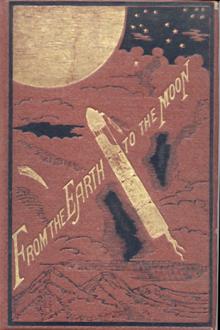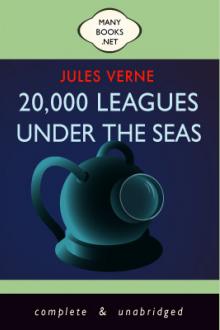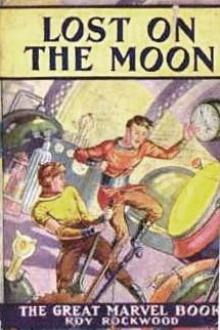From the Earth to the Moon, Jules Verne [online e book reading .TXT] 📗

- Author: Jules Verne
- Performer: -
Book online «From the Earth to the Moon, Jules Verne [online e book reading .TXT] 📗». Author Jules Verne
Overcome with emotion the orator sat down and applied himself to a huge plate of sandwiches before him.
“And now,” said Barbicane, “let us quit the domain of poetry and come direct to the question.”
“By all means,” replied the members, each with his mouth full of sandwich.
“The problem before us,” continued the president, “is how to communicate to a projectile a velocity of 12,000 yards per second. Let us at present examine the velocities hitherto attained. General Morgan will be able to enlighten us on this point.”
“And the more easily,” replied the general, “that during the war I was a member of the committee of experiments. I may say, then, that the 100-pounder Dahlgrens, which carried a distance of 5,000 yards, impressed upon their projectile an initial velocity of 500 yards a second. The Rodman Columbiad threw a shot weighing half a ton a distance of six miles, with a velocity of 800 yards per second— a result which Armstrong and Palisser have never obtained in England.”
“This,” replied Barbicane, “is, I believe, the maximum velocity ever attained?”
“It is so,” replied the general.
“Ah!” groaned J. T. Maston, “if my mortar had not burst–-”
“Yes,” quietly replied Barbicane, “but it did burst. We must take, then, for our starting point, this velocity of 800 yards. We must increase it twenty-fold. Now, reserving for another discussion the means of producing this velocity, I will call your attention to the dimensions which it will be proper to assign to the shot. You understand that we have nothing to do here with projectiles weighing at most but half a ton.”
“Why not?” demanded the major.
“Because the shot,” quickly replied J. T. Maston, “must be big enough to attract the attention of the inhabitants of the moon, if there are any?”
“Yes,” replied Barbicane, “and for another reason more important still.”
“What mean you?” asked the major.
“I mean that it is not enough to discharge a projectile, and then take no further notice of it; we must follow it throughout its course, up to the moment when it shall reach its goal.”
“What?” shouted the general and the major in great surprise.
“Undoubtedly,” replied Barbicane composedly, “or our experiment would produce no result.”
“But then,” replied the major, “you will have to give this projectile enormous dimensions.”
“No! Be so good as to listen. You know that optical instruments have acquired great perfection; with certain instruments we have succeeded in obtaining enlargements of 6,000 times and reducing the moon to within forty miles’ distance. Now, at this distance, any objects sixty feet square would be perfectly visible.
“If, then, the penetrative power of telescopes has not been further increased, it is because that power detracts from their light; and the moon, which is but a reflecting mirror, does not give back sufficient light to enable us to perceive objects of lesser magnitude.”
“Well, then, what do you propose to do?” asked the general. “Would you give your projectile a diameter of sixty feet?”
“Not so.”
“Do you intend, then, to increase the luminous power of the moon?”
“Exactly so. If I can succeed in diminishing the density of the atmosphere through which the moon’s light has to travel I shall have rendered her light more intense. To effect that object it will be enough to establish a telescope on some elevated mountain. That is what we will do.”
“I give it up,” answered the major. “You have such a way of simplifying things. And what enlargement do you expect to obtain in this way?”
“One of 48,000 times, which should bring the moon within an apparent distance of five miles; and, in order to be visible, objects need not have a diameter of more than nine feet.”
“So, then,” cried J. T. Maston, “our projectile need not be more than nine feet in diameter.”
“Let me observe, however,” interrupted Major Elphinstone, “this will involve a weight such as–-”
“My dear major,” replied Barbicane, “before discussing its weight permit me to enumerate some of the marvels which our ancestors have achieved in this respect. I don’t mean to pretend that the science of gunnery has not advanced, but it is as well to bear in mind that during the middle ages they obtained results more surprising, I will venture to say, than ours. For instance, during the siege of Constantinople by Mahomet II., in 1453, stone shot of 1,900 pounds weight were employed. At Malta, in the time of the knights, there was a gun of the fortress of St. Elmo which threw a projectile weighing 2,500 pounds. And, now, what is the extent of what we have seen ourselves? Armstrong guns discharging shot of 500 pounds, and the Rodman guns projectiles of half a ton! It seems, then, that if projectiles have gained in range, they have lost far more in weight. Now, if we turn our efforts in that direction, we ought to arrive, with the progress on science, at ten times the weight of the shot of Mahomet II. and the Knights of Malta.”
“Clearly,” replied the major; “but what metal do you calculate upon employing?”
“Simply cast iron,” said General Morgan.
“But,” interrupted the major, “since the weight of a shot is proportionate to its volume, an iron ball of nine feet in diameter would be of tremendous weight.”
“Yes, if it were solid, not if it were hollow.”
“Hollow? then it would be a shell?”
“Yes, a shell,” replied Barbicane; “decidely it must be. A solid shot of 108 inches would weigh more than 200,000 pounds, a weight evidently far too great. Still, as we must reserve a certain stability for our projectile, I propose to give it a weight of 20,000 pounds.”
“What, then, will be the thickness of the sides?” asked the major.
“If we follow the usual proportion,” replied Morgan, “a diameter of 108 inches would require sides of two feet thickness, or less.”
“That would be too much,” replied Barbicane; “for you will observe that the question is not that of a shot intended to pierce an iron plate; it will suffice to give it sides strong enough to resist the pressure of the gas. The problem, therefore, is this— What thickness ought a cast-iron shell to have in order not to weight more than 20,000 pounds? Our clever secretary will soon enlighten us upon this point.”
“Nothing easier.” replied the worthy secretary of the committee; and, rapidly tracing a few algebraical formulae upon paper, among which n^2 and x^2 frequently appeared, he presently said:
“The sides will require a thickness of less than two inches.”
“Will that be enough?” asked the major doubtfully.
“Clearly not!” replied the president.
“What is to be done, then?” said Elphinstone, with a puzzled air.
“Employ another metal instead of iron.”
“Copper?” said Morgan.
“No! that would be too heavy. I have better than that to offer.”
“What then?” asked the major.
“Aluminum!” replied Barbicane.
“Aluminum?” cried his three colleagues in chorus.
“Unquestionably, my friends. This valuable metal possesses the whiteness of silver, the indestructibility of gold, the tenacity of iron, the fusibility of copper, the lightness of glass. It is easily wrought, is very widely distributed, forming the base of most of the rocks, is three times lighter than iron, and seems to have been created for the express purpose of furnishing us with the material for our projectile.”
“But, my dear president,” said the major, “is not the cost price of aluminum extremely high?”
“It was so at its first discovery, but it has fallen now to nine dollars a pound.”
“But still, nine dollars a pound!” replied the major, who was not willing readily to give in; “even that is an enormous price.”
“Undoubtedly, my dear major; but not beyond our reach.”
“What will the projectile weigh then?” asked Morgan.
“Here is the result of my calculations,” replied Barbicane. “A shot of 108 inches in diameter, and twelve inches in thickness, would weigh, in cast-iron, 67,440 pounds; cast in aluminum, its weight will be reduced to 19,250 pounds.”
“Capital!” cried the major; “but do you know that, at nine dollars a pound, this projectile will cost–-”
“One hundred and seventy-three thousand and fifty dollars ($173,050). I know it quite well. But fear not, my friends; the money will not be wanting for our enterprise. I will answer for it. Now what say you to aluminum, gentlemen?”
“Adopted!” replied the three members of the committee. So ended the first meeting. The question of the projectile was definitely settled.
HISTORY OF THE CANNON
The resolutions passed at the last meeting produced a great effect out of doors. Timid people took fright at the idea of a shot weighing 20,000 pounds being launched into space; they asked what cannon could ever transmit a sufficient velocity to such a mighty mass. The minutes of the second meeting were destined triumphantly to answer such questions. The following evening the discussion was renewed.
“My dear colleagues,” said Barbicane, without further preamble, “the subject now before us is the construction of the engine, its length, its composition, and its weight. It is probable that we shall end by giving it gigantic dimensions; but however great may be the difficulties in the way, our mechanical genius will readily surmount them. Be good enough, then, to give me your attention, and do not hesitate to make objections at the close. I have no fear of them. The problem before us is how to communicate an initial force of 12,000 yards per second to a shell of 108 inches in diameter, weighing 20,000 pounds. Now when a projectile is launched into space, what happens to it? It is acted upon by three independent forces: the resistance of the air, the attraction of the earth, and the force of impulsion with which it is endowed. Let us examine these three forces. The resistance of the air is of little importance. The atmosphere of the earth does not exceed forty miles. Now, with the given rapidity, the projectile will have traversed this in five seconds, and the period is too brief for the resistance of the medium to be regarded otherwise than as insignificant. Proceding, then, to the attraction of the earth, that is, the weight of the shell, we know that this weight will diminish in the inverse ratio of the square of the distance. When a body left to itself falls to the surface of the earth, it falls five feet in the first second; and if the same body were removed 257,542 miles further off, in other words, to the distance of the moon, its fall would be reduced to about half a line in the first second. That is almost equivalent to a state of perfect rest. Our business, then, is to overcome progressively this action of gravitation. The mode of accomplishing that is by the force of impulsion.”
“There’s the difficulty,” broke in the major.
“True,” replied the president; “but we will overcome that, for the force of impulsion will depend on the length of the engine and the powder employed, the latter being limited only by the resisting power of the former. Our business, then, to-day is with the dimensions of the cannon.”
“Now, up to the present time,” said Barbicane, “our longest guns have not exceeded twenty-five





Comments (0)